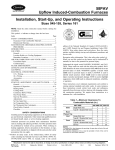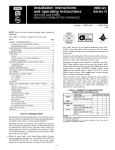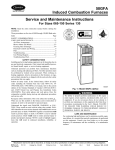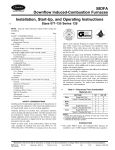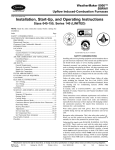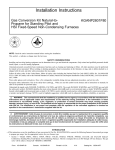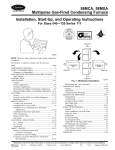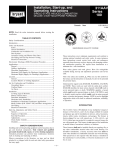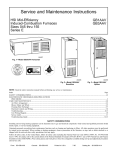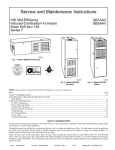Download Carrier INDUCED COMBUSTION FURNACES 58GFA Operating instructions
Transcript
58GFA Upflow Induced-Combustion Furnaces Installation, Start-Up, and Operating Instructions Sizes 065-150, Series 130 NOTE: Read the entire instruction manual before starting the installation. This symbol → indicates a change since the last issue. Index Page SAFETY CONSIDERATIONS ................................................. 1 INTRODUCTION ................................................................... 1-2 Clearance From Combustible Materials ..................................1 Dimensional Drawing ...............................................................2 LOCATION ..............................................................................2-3 General .................................................................................2-3 Location Relative to Cooling Equipment ................................3 Hazardous Locations.................................................................3 AIR FOR COMBUSTION AND VENTILATION...................3-4 Unconfined Space .....................................................................3 Confined Space......................................................................3-4 FILTER ARRANGEMENT .......................................................4-5 LEVELING LEGS ....................................................................5-6 GAS PIPING ................................................................................6 ELECTRICAL CONNECTIONS .............................................6-7 115-v Wiring ...........................................................................6 24-v Wiring...............................................................................7 Accessory ..................................................................................7 VENTING ....................................................................................7 START-UP, ADJUSTMENT, AND SAFETY CHECK.........7-13 Sequence Of Operation.............................................................8 Heating Mode............................................................................8 Cooling Mode ...........................................................................8 Continuous Blower Mode.........................................................8 Start-up Procedures..............................................................8-10 Adjustments .......................................................................10-12 Check Safety Controls.......................................................12-13 Checklist..................................................................................13 SAFETY CONSIDERATIONS Installing and servicing heating equipment can be hazardous due to gas and electrical components. Only trained and qualified personnel should install, repair, or service heating equipment. Untrained personnel can perform basic maintenance functions such as cleaning and replacing air filters. All other operations must be performed by trained service personnel. When working on heating equipment, observe precautions in the literature, on tags, and on labels attached to or shipped with the unit and other safety precautions that may apply. Follow all safety codes. In the United States, follow all safety codes including the National Fuel Gas Code NFPA No. 541992/ANSI Z223.1-1992 (NFGC). In Canada, refer to the current edition of the National Standard of Canada CAN/CGA-B149.1and .2-M95 Natural Gas and Propane Gas Installation Codes (NSCNGPIC). Wear safety glasses and work gloves. Have fire extinguisher available during start-up and adjustment procedures and service calls. ® ama CANADIAN GAS ASSOCIATION A PP R O VED R Recognize safety information. This is the safety-alert symbol . When you see this symbol on the furnace and in instructions or manuals, be alert to the potential for personal injury. Understand the signal word DANGER, WARNING, or CAUTION. These words are used with the safety-alert symbol. DANGER identifies the most serious hazards which will result in severe personal injury or death. WARNING signifies a hazard which could result in personal injury or death. CAUTION is used to identify unsafe practices which would result in minor personal injury or product and property damage. NOTE is used to highlight suggestions which will result in enhanced installation, reliability, or operation. These instructions cover minimum requirements and conform to existing national standards and safety codes. In some instances, these instructions exceed certain local codes and ordinances, especially those that may not have kept up with changing residential construction practices. We require these instructions as a minimum for a safe installation. INTRODUCTION model 58GFA Series 130 Furnaces are available in sizes 65,000 through 150,000 Btuh input capacities. → The The design of the upflow gas-fired furnace is A.G.A./C.G.A. certified for natural and propane gas and for installation on combustible flooring, in alcoves, attics, basements, closets, or utility rooms. The design of this furnace line is not A.G.A./C.G.A. certified for installation in mobile homes, recreation vehicles, or outdoors. Table 1—Minimum Clearances From Combustible Materials (In.) UNIT SIZE Sides Back Top of Plenum Vent Front Single-Wall Vent Type B-1 Double-Wall Vent Single-Wall Vent Type B-1 Double-Wall Vent Single-Wall Vent Type B-1 Double-Wall Vent Service 065 1 0 0 1 6 1 6 3 30 086-150 0 0 0 1 6 1 6 3 30 NOTES: 1. Provide 30-in. front clearance for servicing. An open door in front of the furnace can meet this requirement. 2. A minimum clearance of 3 in. must be provided in front of the furnace for combustion air and proper operation. Manufacturer reserves the right to discontinue, or change at any time, specifications or designs without notice and without incurring obligations. Book 1 4 PC 101 Catalog No. 535-809 Printed in U.S.A. Form 58GF-4SI Pg 1 10-95 Replaces: 58GF-3SI Tab 6a 8a AIRFLOW 28 1⁄2″ 2 1⁄16″ FLUE COLLAR DIA HOLE POWER ENTRY 7⁄8-IN. DIA ACCESSORY 5 3⁄8″ 12 5⁄16″ 2 11⁄16″ 5 13⁄16″ 5 13⁄16″ 2 3⁄8″ 1 3⁄4-IN. DIA HOLE GAS ENTRY 7⁄8-IN. DIA POWER ENTRY 1 1⁄2-IN. DIA R.H. GAS ENTRY 7⁄8-IN. DIA ACCESSORY 1⁄2-IN. DIA THERMOSTAT WIRE ENTRY 2 3⁄8″ DIA HOLE THERMOSTAT WIRE ENTRY 13⁄16″ OUTLET 1″ 5 3⁄8″ 1⁄2-IN. 19″ 13⁄16″ 1″ 7⁄8-IN. 39 7⁄8″ 2 1⁄16″ A D SIDE INLET SIDE INLET 141⁄2″ TYP 1″ 1 3⁄4″ 11⁄16″ 24 5⁄16″ AIR INLET 3″ 11⁄16″ E 11⁄16″ 5⁄8″ TYP 1″ 231⁄4″ SIDE RETURN DUCT LOCATION NOTE: 2 additional 7⁄8 In. Dia knockouts are located in the top plate. NOTES: Minimum return-air opening at furnace: 1. For 800 CFM–16-In. round or 141⁄2 x 12-In. rectangle. 2. For 1200 CFM–20-In. round or 141⁄2 x 191⁄2-In. rectangle. 3. For 1600 CFM–22-In. round or 141⁄2 x 231⁄4-In. rectangle. 4. For airflow requirements above 1800 CFM, use both side inlets, a combination of 1 side inlet and the bottom, or the bottom only. A88367 Table 2—Dimensions (In.) UNIT SIZE 065-08 065-12 086-14 086-16 105-12 105-16 105-22 130-16 130-20 150-20 A 14-3/16 14-3/16 17-1/2 21 17-1/2 21 24-1/2 21 24-1/2 24-1/2 D 12-9/16 12-9/16 15-7/8 19-3/8 15-7/8 19-3/8 22-7/8 19-3/8 22-7/8 22-7/8 E 12-11/16 12-11/16 16 19-1/2 16 19-1/2 23 19-1/2 23 23 VENT CONN 4 4 4 4 4 4 4 5 5 5 SHIP. WT 126 128 143 147 153 159 176 171 186 196 Fig. 1—Dimensional Drawing Before installing the furnace, refer to the current edition of the NFGC. Canadian installations must be installed in accordance with NSCNGPIC and all authorities having jurisdiction. For further information, the National Fuel Gas Code is available from National Fire Protection Association Inc., Batterymarch Park, Quincy, MA 02269, American Gas Association, 1515 Wilson Boulevard, Arlington, VA 22209, or from Literature Distribution. Installation must conform to the regulations of the serving gas supplier and the local building, heating, and plumbing codes in effect in the area in which the installation is made, or in the absence of local codes with the requirements of the NFGC. Improper installation, adjustment, alteration, service, maintenance, or use can cause carbon monoxide poisoning, explosion, fire, electrical shock, or other conditions which may cause personal injury or property damage. Consult a qualified installer, service agency, local gas supplier, or your distributor or branch for information or assistance. The qualified installer or agency must use only factory-authorized and listed kits or accessories when modifying this product. Failure to follow this warning can cause electrical shock, fire, personal injury, or death. For accessory installation details, refer to the applicable instruction literature. Application of this furnace should be indoors with special attention given to vent sizing and material, gas input rate, air temperature rise, and unit sizing. Improper installation or misapplication of the furnace can require excessive servicing or cause premature component failure. NOTE: Remove all shipping brackets and materials before operating the furnace. Step 1—Location GENERAL This furnace is designed for a minimum continuous return-air temperature of 60°F db or an intermittent operation down to 55°F db such as when used with a night setback thermostat. Return-air temperature must not exceed a maximum of 85°F db. Do not install furnace in a corrosive or contaminated atmosphere. Make sure all combustion and circulating air requirements are met, in addition to all local codes and ordinances. 2 Do not use this furnace during construction when adhesives, sealers, and/or new carpets are being installed. If the furnace is required during construction, use clean outside air for combustion and ventilation. Compounds of chlorine and fluorine when burned with combustion air form acids which will cause corrosion of the heat exchangers and metal vent system. Some of these compounds are found in paneling and dry wall adhesives, paints, thinners, masonry cleaning materials, and many other solvents commonly used in the construction process. Excessive exposure to contaminated combustion air will result in safety and performance related problems. The operation of exhaust fans, kitchen ventilation fans, clothes dryers, or fireplaces could create a NEGATIVE PRESSURE condition at the furnace. Makeup air MUST be provided for the ventilation devices, in addition to that required by the furnace. Combustion air requirements are determined by whether the furnace is in an UNCONFINED or CONFINED space. UNCONFINED SPACE — An unconfined space must have at least 50 cu ft for each 1000 Btuh of input for all the appliances (such as furnaces, clothes dryer, water heaters, etc.) in the space. For Example: This furnace must be installed so the electrical components are protected from water. Locate the furnace close to the chimney/vent and as near the center of the air distribution system as possible. The furnace should be installed level. 58GFA FURNACE INPUT BTUH 63,000 84,000 105,000 126,000 147,000 When a furnace is installed so that the supply ducts carry air to areas outside the space containing the furnace, the return air must also be handled by a duct(s) sealed to the furnace casing and terminating outside the space containing the furnace. MINIMUM SQ FT WITH 7-1/2 FT CEILING 420 560 700 840 980 If the unconfined space is of unusually tight construction, air for combustion and ventilation MUST come from either the outdoors or spaces freely communicating with the outdoors. Combustion and ventilation openings must be sized the same as for a confined space. A minimum opening with a total of not less than 1 sq in. per 5000 Btuh of total input rating for all equipment must be provided. Return air must not be taken from the room unless an equal or greater amount of air is supplied to the room. Provide ample space for servicing and cleaning. Always comply with the minimum fire protection clearances shown on the unit rating plate. This furnace shall not be installed directly on carpeting, tile, or any combustible material other than wood flooring. LOCATION RELATIVE TO COOLING EQUIPMENT — The cooling coil must be installed parallel with or on the downstream side of the furnace to avoid condensation in the heat exchangers. When installed parallel with a furnace, dampers or other means used to control the flow of air must prevent chilled air from entering the unit. If the dampers are manually operated, they must be equipped with means to prevent operation of either unit unless the damper is in the full-heat or full-cool position. CONFINED SPACE — A confined space is one whose volume is less than 50 cu ft per 1000 Btuh of the total output rating for all appliances installed in that space. A confined space MUST have 2 permanent openings, 1 within 12 in. of the ceiling, and the other within 12 in. of the floor. (See Fig. 2.) NOTE: In determining the free area of an opening, the blocking effect of the louvers, grilles, and screens must be considered. If the free area of a louver or grille design is unknown, it may be assumed that wood louvers have a 20 percent free area and metal louvers or grilles have a 60 percent free area. Screens, when used, must not be smaller than 1/4-in. mesh. Louvers and grilles must be constructed so they cannot be closed. The size of the openings depends upon whether the air comes from inside or outside of the structure. 1. All air from inside the structure: Each opening MUST have at least 1 sq in. of free area per 1000 Btuh of the total input for all equipment within the confined space, but not less than 100 sq in. per opening. (See Fig. 2.) For Example: HAZARDOUS LOCATIONS — When the furnace is installed in a residential garage, it must be installed so that the burners and ignition source are located at least 18 in. above the floor. The furnace should be protected from physical damage by vehicles. When a furnace is installed in public garages, airplane hangars, or other buildings having hazardous atmospheres, the unit must be installed in accordance with the recommended good practice requirements of the National Fire Protection Association, Inc. Step 2—Air for Combustion and Ventilation Provisions for adequate combustion and ventilation air must be provided in accordance with Section 5.3, Air for Combustion and Ventilation, of the NFGC or applicable provisions of the local building codes. Canadian installations must be in accordance with NSCNGPIC. 58GFA FURNACE INPUT BTUH 63,000 84,000 105,000 126,000 147,000 Air for combustion must not be contaminated by halogen compounds, which include fluoride, chloride, bromide, and iodide. These elements are found in aerosol sprays, detergents, bleaches, cleaning solvents, salts, air fresheners, and other household products. FREE AREA PER OPENING (SQ IN.) 100 100 105 126 147 If the building is constructed unusually tight, a permanent opening directly communicating with the outdoors should be provided. This opening shall have a minimum free area of 1 sq in. per 5000 Btuh of total input rating for all equipment in the enclosure. All fuel-burning equipment must be supplied with air for combustion of the fuel. Sufficient air MUST be provided to ensure there will not be a negative pressure in the equipment room or space. In addition, a positive seal MUST be made between the furnace cabinet and the return-air duct to prevent air from being pulled from the burner area and draft safeguard opening. 3 For Example: SUPPLY AIR 58GFA FURNACE INPUT BTUH 63,000 84,000 105,000 126,000 147,000 VENT THROUGH ROOF CONFINED SPACE 12″ MAX INTERIOR HEATED SPACE FREE AREA PER OPENING (SQ IN.) 31.5 42.0 52.5 63.0 73.5 ROUND PIPE (IN. DIA) 7 8 9 9 10 When ducts are used, they must be of the same cross-sectional area as the free area of the openings to which they connect. The minimum dimension of rectangular ducts must not be less than 3 in. (See Fig. 3.) 1 SQ IN. PER 1000 BTUH* IN DOOR OR WALL UNCONFINED SPACE 1 SQ IN. PER 4000 BTUH* DUCTS TO OUTDOORS 6″ MIN (FRONT) † 1 SQ IN. PER 1000 BTUH* IN DOOR OR WALL 12″ MAX 1 SQ IN. PER 2000 BTUH* A D VENT THROUGH SUPPLY ROOF AIR 12″ MAX F 1 SQ IN. PER 4000 BTUH* CONFINED SPACE RETURN AIR DUCTS TO OUTDOORS * Minimum opening size is 100 square in. with minimum dimensions of 3-In. † Minimum of 3-In. when type-B1 vent is used. OUTDOORS 12″ MAX 1 SQ IN. PER 4000 BTUH* A89012 Fig. 2—Air for Combustion and Ventilation (Inside Air) 1 SQ IN. PER 2000 BTUH* 12″ MAX G 12″ MAX C 12″ MAX If the furnace is installed on a raised platform to provide a returnair plenum, and return air is taken directly from the hallway or space adjacent to the furnace, all air for combustion must come from outdoors. RETURN AIR 2. All air from outside the structure: a. If combustion air is taken from outdoors through vertical ducts, the openings and ducts MUST have at least 1 sq in. of free area per 4000 Btuh of the total input for all equipment within the confined space. (See Fig. 3.) DUCT TO OUTDOORS 1 SQ IN. PER 4000 BTUH* *Minimum dimensions of 3-In. NOTE: Use any of the following combinations of openings: A&B C&D D&E F&G A89013 For Example: 58GFA FURNACE INPUT BTUH 63,000 84,000 105,000 126,000 147,000 E B FREE AREA PER OPENING (SQ IN.) 16.0 21.0 26.5 31.5 37.0 Fig. 3—Air for Combustion and Ventilation (Outside Air) ROUND PIPE (IN. DIA) 5 6 6 7 7 Do not install the furnace on its back; safety control operation will be adversely affected. Never connect return-air ducts to the back of the furnace. Failure to follow this warning can cause a fire, personal injury, or death. b. If combustion air is taken from the outdoors through horizontal ducts, the openings and ducts MUST have at least 1 sq in. of free area per 2000 Btuh of the total input for all equipment within the confined space. Step 3—Filter Arrangement The factory-supplied filter(s) is shipped in the blower compartment. Determine location for the filter and move filter retaining hardware, if necessary, before attaching the return-air duct. After the return-air duct has been connected to the furnace, install the filter(s) inside the furnace blower compartment. See Fig. 4 for side return application and Fig. 5 for bottom return application. 4 A bottom closure panel is factory installed in the bottom of the furnace. When bottom return inlet is desired, remove and discard the enclosure panel. 3″ Filter retaining brackets, supports, and retainers are factory assembled and shipped installed for side return application, with 1 set of all required hardware provided. (See Fig. 4.) For bottom return applications, remove the brackets (front and back) and supports from each side. The back bracket(s) are installed in the rear of the furnace casing. Dimples are provided to mark mounting screw locations. 24 1/2″ 1″ FIELD-SUPPLIED FILTER FILLER STRIP FOR 171⁄ 2-IN. WIDE CASINGS ONLY. INSTALL UNDER FILTER. The front bracket(s) are installed on the bottom front plate as shown in Fig. 5, once the bottom enclosure has been removed. Rotate filter supports 180° so filter will rest on support, and reinstall. (Do not reinstall in 17-1/2 in. casing.) Install the filter retaining rod (small U-shaped end) in the rear bracket, and the front of the filter retainer rod as shown in Fig. 5. Two sets of hardware are needed for furnaces in 24-1/2 in. casings using 1 filter for bottom return. All hardware is provided for filter installation. WASHABLE FILTER WASHABLE FILTER FILTER RETAINER FILTER SUPPORT FILTER RETAINER A93321 Fig. 5—Bottom Filter Arrangement A93045 Fig. 4—Side Filter Arrangement 5⁄16″ Never operate unit without a filter or with filter access door removed. Failure to follow this warning can cause fire, personal injury, or death. 5⁄16″ 1 3⁄4″ Table 3—Filter Information (In.) FURNACE CASING WIDTH 14-3/16 17-1/2 21 24-1/2 FILTER QUANTITY AND SIZE* FILTER TYPE Side Return Bottom Return (1) 16 X 25 X 1† (1) 14 X 25 X 1 Cleanable (1) 16 X 25 X 1† (1) 16 X 25 X 1 Cleanable (1) 16 X 25 X 1 (1) 20 X 25 X 1† Cleanable (2) 16 X 25 X 1† (1) 24 X 25 X 1 Cleanable * Filter can be field modified by cutting to the desired size. Alternate sizes can be ordered from your distributor or dealer. † Factory provided with the furnace. 1 3⁄4″ 5⁄16″ Step 4—Leveling Legs (If Required) When the furnace is used with side inlet(s) and leveling legs are required, refer to Fig. 6, and install field-supplied, corrosionresistant 5/16-in. machine bolts and nuts. NOTE: The maximum length of the bolt should not exceed 1-1/2 in. 5⁄16″ 1 3⁄4″ 1 3⁄4″ 1. Lay furnace on its back. Locate and drill 5/16-in. diameter hole in each bottom corner of furnace as shown in Fig. 6. A89014 Fig. 6—Leveling Leg Installation 2. Install nut on bolt and install bolt and nut in hole. (Install flat washer if desired.) 5 3. Install another nut on other side of furnace base. (Install flat washer if desired.) 4. Adjust outside nut to provide desired height, and tighten inside nut to secure arrangement. Step 5—Gas Piping Gas piping must be installed in accordance with national and local codes. Refer to the current edition of the NFGC. Canadian installations must be installed in accordance with NSCNGPIC and all authorities having jurisdiction. The gas supply line should be a separate line running directly from the gas meter to the furnace, if possible. Refer to Table 4 for the recommended gas pipe size. Risers must be used to connect to the furnace and the meter. Table 4—Maximum Capacity of Pipe* NOMINAL IRON INTERNAL PIPE SIZE (IN.) DIAMETER (IN.) 1/2 3/4 1 1-1/4 1-1/2 0.622 0.824 1.049 1.380 1.610 LENGTH 10 20 175 120 360 250 680 465 1400 950 2100 1460 OF PIPE (FT) 30 40 50 97 82 73 200 170 151 375 320 285 770 660 580 1180 990 900 A89417 Fig. 7—Typical Gas Pipe Arrangement * Cubic ft of gas per hr for gas pressures of 0.5 psig (14-in. wc) or less, and a pressure drop of 0.5-in. wc (based on a 0.60 specific gravity gas). Ref: Table C-2 NFPA 54-1992. Use the proper length of pipes to avoid stress on the gas control manifold. Failure to follow this warning can cause a gas leak resulting in fire, explosion, personal injury, or death. If a flexible connector is required or allowed by the authority having jurisdiction, black iron pipe shall be installed at the gas valve and extend a minimum of 2 in. outside the furnace casing. Connect the gas pipe to the furnace using a backup wrench to avoid damaging gas controls. Piping should be pressure tested in accordance with local and national plumbing and gas codes before the furnace has been attached. If the pressure exceeds 0.5 psig (14-in. wc), the gas supply pipe must be disconnected from the furnace and capped before the pressure test. If the test pressure is equal to or less than 0.5 psig (14-in. wc), close the manual shut-off valve located on the gas valve before the test. It is recommended that the ground joint union be loosened before pressure testing. After all connections have been made, purge the lines and check for leakage with regulated gas supply pressure. Step 6— Electrical Connections Install a sediment trap in the riser leading to the furnace. The trap can be installed by connecting a tee to the riser leading from the furnace. Connect a capped nipple into the lower end of the tee. The capped nipple should extend below the level of the gas controls. (See Fig. 7.) Make all electrical connections in accordance with the National Electrical Code ANSI/NFPA 70-1990 and local codes or ordinances that might apply. For Canadian installations, all electrical connections must be made in accordance with Canadian Electrical Code CSA C22.1 or authorities having jurisdiction. 115-V WIRING — Refer to the unit rating plate or Table 5 for equipment electrical requirements. The control system requires an earth ground for proper operation. Do not connect aluminum wire between disconnect switch and furnace. Use only copper wire. Apply joint compound (pipe dope) sparingly and only to the male threads of each joint. The compound must be resistant to the action of propane gas. The cabinet MUST have an uninterrupted or unbroken ground according to National Electrical Code ANSI/NFPA 70-1990 and Canadian Electrical Code CSA C22.1 or local codes to minimize personal injury if an electrical fault should occur. This may consist of electrical wire or conduit approved for electrical ground when installed in accordance with existing electrical codes. Do not use gas piping as an electrical ground. Never purge a line into a combustion chamber. Never use matches, candles, flame, or other sources of ignition for the purpose of checking leakage. Use a soap-and-water solution to check for leakage. Failure to follow this warning can cause fire, explosion, personal injury, or death. The auxiliary junction box can be moved to the right-hand side of the furnace when a right side power supply is desired. Remove the 2 screws holding the auxiliary junction box. Mount the junction box on the right-hand side of the furnace (holes have been predrilled in casing). The blower door interlock switch must also be moved to the right-hand side of the furnace due to the length of the wiring harness. When moved, tuck the wiring harness behind the clip provided to keep extra wire lengths out of the way. Install accessible manual shut-off valve upstream of the furnace gas controls and within 72 in. of the furnace. A 1/8-in. NPT plugged tapping, accessible for test gage connection, must be installed immediately upstream of the gas supply connection to the furnace and downstream of the manual shut-off valve. Place ground joint union between the gas control manifold and the manual shut-off valve. 6 FIELD 24-VOLT WIRING FIELD 115-, 208/230-, 460-VOLT WIRING FACTORY 24-VOLT WIRING FACTORY 115-VOLT WIRING NOTE 2 W FIVE WIRE C R G Y THERMOSTAT TERMINALS FIELD-SUPPLIED FUSED DISCONNECT THREE-WIRE HEATINGONLY BLK BLK W WHT WHT R GND GND 115-VOLT FIELD- AUXILIARY J-BOX SUPPLIED CONTROL FUSED BOX DISCONNECT 208/230- OR 460-VOLT THREE PHASE G C GND NOTE 1 CONDENSING UNIT Y 24-VOLT TERMINAL BLOCK FURNACE 208/230VOLT SINGLE PHASE TWO WIRE NOTES: 1. Connect Y-terminal as shown for proper operation. 2. Some thermostats require a "C" terminal connection as shown. 3. If any of the original wire, as supplied, must be replaced, use same type or equivalent wire. A95241 → Table 5—Electrical Data UNIT SIZE VOLTS— HERTZ— PHASE 065-08 065-12 086-14 086-16 105-12 105-16 105-22 130-16 130-20 150-20 115—60—1 115—60—1 115—60—1 115—60—1 115—60—1 115—60—1 115—60—1 115—60—1 115—60—1 115—60—1 OPERATING VOLTAGE RANGE Max* Min* 127 104 127 104 127 104 127 104 127 104 127 104 127 104 127 104 127 104 127 104 MAX UNIT AMPS MIN WIRE GAGE MAX WIRE LENGTH (FT)‡ MAX FUSE OR HACR-TYPE CKT BKR AMPS† 7.1 8.7 9.0 10.4 8.0 10.1 14.4 10.1 13.3 13.7 14 14 14 14 14 14 12 14 12 12 41 34 33 28 37 29 33 29 36 35 15 15 15 15 15 15 20 15 20 20 * Permissible limits of the voltage range at which the unit will operate satisfactorily. † Time-delay fuse is recommended. ‡ Length shown is as measured 1 way along wire path between unit and service panel for maximum 2 percent voltage drop. Fig. 8—Heating and Cooling Application Wiring Diagram system shall maintain a minimum of 1/4-in. upward slope per linear ft and it shall be rigidly supported every 5 ft or less with hangers or straps to ensure that there will be no movement after installation. Step 8—Start-Up, Adjustment, and Safety Check 24-V WIRING — Make field 24-v connections at the 24-v terminal strip. (See Fig. 8 and 9.) Connect terminal Y as shown in Fig. 8 for proper cooling operation. Use only AWG No. 18, colorcoded copper thermostat wire. The 24-v circuit contains an automotive-type, 3-amp fuse located on the main control board. Any direct shorts during installation, service, or maintenance could cause this fuse to blow. If fuse replacement is required, use ONLY a 3-amp fuse of identical size. GENERAL — The furnace must have a 115-v power supply properly connected and grounded. Thermostat wire connections at R, W, C, and Y must be made at the 24-v terminal block on the control board. The gas service pressure must not exceed 0.5 psig (14-in. wc), but must be no less than 0.16 psig (4.5-in. wc). → ACCESSORY Electronic air cleaner (EAC) Two terminals (EAC-1 and EAC-2) are provided for EAC connection. The terminals are energized with 115-v, 1-amp maximum during blower motor operation. Step 7—Venting Refer to the enclosed Installation Instructions, GAMA Venting Tables for Category I Furnaces and venting tables for Category I Fan-Assisted Furnaces. The horizontal portion of the venting 7 115-VAC NEUTRAL TERMINALS This furnace is equipped with a fuse link in the gas control area. The fuse link will open and shut off power to the gas valve if a flame rollout or overheating condition occurs in the gas control area. DO NOT bypass the fuse link. Call your service dealer to correct inadequate combustion-air supply problem and replace fuse link. 115-VAC LINE VOLTAGE HEATING SPEED TAP TERMINAL 115-VAC TRANSFORMER 1 COM PR-2 EAC-2 L2 CFR L1 HFR PR-1 LO Before operating the furnace, check each manual reset switch for continuity. If necessary, press the button to reset the switch. 1 4 7 2 5 8 3 6 9 PL-1 3 HI EAC-1 9-PIN CONNECTOR The blower compartment door must be in place to complete the 115-v circuit to the furnace. IDR SPARE-1 SEQUENCE OF OPERATION — Using the schematic diagram show in Fig. 10, follow the sequence of operation through the different modes. ELECTRONIC AIR-CLEANER TERMINALS NOTE: When the blower door is in place, 115v is supplied through blower door interlock switch ILK to heating fan relay HFR, induced draft relay IDR, and transformer TRAN. Transformer TRAN energizes the safety circuit containing fuse link FL and limit switch LS to energize R. W 24-VAC COMMON COOLING SPEED TAP TERMINAL SPARE-2 Y1 R SEC-2 24-VAC POWER C SEC-1 FU G 3-AMP FUSE GROUND SCREW REQUIRED CES0110074-01 The furnace pilot must be lit so the thermocouple energizes the thermal magnet circuit of gas valve GV, which permits gas flow to the remaining portion of the valve. 24VAC COMMON BLOWER OFF-DELAY 24-VAC THERMOSTAT TERMINALS 24-VAC FUSE 3-AMP ONLY 1. Heating mode BLOWER OFF-TIME ADJUSTMENT a. When the wall thermostat "calls for heat" the R-W circuit closes. This closed circuit supplies power to the 24-v safety circuit containing automatic reset limit switch LS and fuse link FL. → b. The inducer-motor relay coil IDR is energized. Inducer motor relay contacts in the 115-v circuit close, starting inducer motor IDM. Simultaneously, another set of contacts in inducer-motor relay IDR close in the 24-v circuit and lock-in until the R-W circuit or safety opens. A95463 Fig. 9—Control Center the furnace skips the blower on delay and immediately starts the blower. 2. Cooling mode When the wall thermostat "calls for cooling" the R, G, and Y circuits close. Simultaneously, the R-Y circuit starts the outdoor condensing unit, the R-G circuit energizes cooling relay coil CFR, and heating fan relay coil HFR. The normally open contact of heating fan relay HFR and the normally open contact of cooling relay CFR closes, energizing the cooling speed of blower motor BLWM. The EAC terminals are energized with 115v when the blower is operating on either heating or cooling speed. 3. Continuous blower mode When the R-G circuit is made, the blower motor operates on cooling speed. During a "call for heat", the blower stops, allowing the furnace heat exchangers to heat up more quickly. When the blower motor comes back on it runs on heating speed. The blower reverts to continuous operation after the heating cycle blower off delay is completed. c. As inducer motor IDM comes up to speed, pressure switch PRS actuates and supplies power through manual reset draft safeguard switch DSS. Both solenoid coils in gas valve GV are energized, causing the valve to open and permitting gas flow to the main burners, where it is ignited by the pilot. d. Simultaneously, solid-state time-delay circuit in the blower control center is energized. Approximately 45 sec after the R-W circuit is closed, heating fan relay coil HFR is energized, closing the 115-v contacts of heating fan relay HFR, and starting blower motor BLWM on heating speed. EAC terminals energize with 115v when the blower is operating on either heating or cooling speed. e. When the thermostat is satisfied, the R-W circuit is broken, de-energizing both solenoid coils of gas valve GV and the solid-state time-delay circuit for the heating fan relay HFR. The gas flow to the main burners immediately stops. Approximately 120 sec (or 180 sec depending on the blower off time selected) after main burners are extinguished, heating fan relay HFR is de-energized and blower motor BLWM stops. The blower off delay can be permanently changed to 180 sec by cutting the resistor. (See Fig. 9.) START-UP PROCEDURES — Check to be sure that all connections have been properly made, then light the pilot using the procedure outlined on the lighting/operation instructions label attached to the furnace. However, when lighting the pilot for the first time, perform the following additional steps: 1. Purge gas lines after all connections have been made and check for leaks. f. If the pilot flame is extinguished, the thermocouple no longer energizes the thermal magnet circuit of gas valve GV. Gas flow to the pilot and main burners ceases until the pilot is manually relit. NOTE: When gas valve GV is energized, R-W circuit is closed. After a power interruption, the gas valve closes within 7 sec and 8 GV CONNECTION DIAGRAM DSS MGV TH TR PRS L1 NO BRN L2 TO 115V AC FIELD DISCONNECTIONS ILK C SCHEMATIC DIAGRAM NOTE #4 NC EQUIPMENT GROUND PILOT L1 LS FL ALS SPARE-1 NOTE #9 IDM (WHEN USED) NOTE #6 PL1-3 RED BLU WHT 115V AC LS FL ALS GRN CAP BRN PR2 L2 START YEL WHT RED RED BLU BRN ORN BLK BLU RED BLK PL1 1 4 7 2 5 8 3 6 9 L1 PR1 CFR HFR EAC-1 HFR LOGIC PL1-9 TIME DELAY MGV DSS BLK (HI) GV SPARE-1 YEL (MED HI) SPARE-2 Y IDR NOTE #9 NO NC SEC-2 SEC-1 RED (LO) Y R C G PCB 3AMP FUSE NOTE #7 NOTE #8 PILOT PL1-2 PL1-6 IDR GROUND SCREW REQUIRED W IDR CFR NOTE #1 G LEGEND AUXILIARY LIMIT SWITCH, OVERTEMP. -MANUAL RESET, SPST-(N.C.) BLWM BLOWER MOTOR CAP CAPACITOR CFR COOLING FAN RELAY, SPDT DSS DRAFT SAFEGUARD SWITCH, SPST-(N.C.), MANUAL RESET EAC-1 ELECTRONIC AIR CLEANER CONNECTION (115 VAC) EAC-2 ELECTRONIC AIR CLEANER CONNECTION (COMMON) FL FUSIBLE LINK FU1 FUSE, 3 AMP, AUTOMOTIVE BLADE TYPE FU2 FUSE FIELD INSTALLED GV GAS VALVE-REDUNDANT OPERATORS HFR HEATING FAN RELAY, SPST (N.O.) IDM INDUCED DRAFT MOTOR IDR INDUCED DRAFT RELAY, SPST-(N.O.) ILK BLOWER ACCESS PANEL INTERLOCK SWITCH, SPST-(N.O.) JB JUNCTION BOX LS LIMIT SWITCH, AUTO RESET, SPST(N.C.) OL AUTO-RESET INTERNAL MOTOR OVERLOAD TEMP. SW. PCB PRINTED CIRCUIT BOARD (FURNACE CONTROL) PL1 9-CIRCUIT CONNECTOR (PCB1) PR5 PRESSURE SWITCH, SPDT TRAN TRANSFORMER (115V AC/24V AC) C PL1-8 TR TH PRS RED BLU W → SEC-2 R FU1 ALS PR-2 HI BLU (MED LO) BRN (WHEN USED) NOTE #6 TRAN 24V AC 3A FUSE SEC-1 NOTE #7 LO WHT (COM) OL PL1-7 COM JB EAC-2 BLWM BLK WHT WHT FU1 PR-1 PL1-4 BLK GRN IDM PL1-1 TRAN NOTE #4 ILK GRN BLWM EAC-1 EAC-2 IDR BLK WHT CAP COM COM BLK FU2 START OL COOL WHT FUSED DISCONNECT SWITCH (WHEN REQ’D) L1 LO MED LO MED HI HI SPARE-2 HEAT CFR HFR NOTE #9 C JUNCTION UNMARKED TERMINAL NOTES: PCB TERMINAL FACTORY POWER WIRING (120 AC) FACTORY CONTROL WIRING (120 AC) FIELD POWER WIRING (120 AC) CONDUCTOR ON PCB FIELD WIRING SCREW TERMINAL FIELD GROUND EQUIPMENT GROUND FIELD SPLICE PLUG RECEPTACLE 1. Internally connected to equipment ground through mounting screw. 2. If any of the original equipment wire is replaced, use wire rated for 105°C. 3. Blower motor (BLWM) & Inducer motor (IDM) contain auto-reset thermal overload switch. 4. Use only copper wire between the disconnect switch and the furnace junction box (JB). 5. Symbols are electrical representations only6. 6. Auxiliary limit switch (ALS) used on downflow models only. 7. The transformer 24VAC winding is protected by a 3 AMP automotive blade type fuse on the control board. A 24VAC short to ground during installation, checkout, operation, service or maintenance could cause this fuse to open. Do not replace the 3 AMP fuse with any other size fuse. 8. Blower motor (BLWM) adjustable OFF-DELAY. Factory set: 120 seconds cut resistor: 180 seconds. 9. When CFR relay is energized, HFR relay is also energized. 322876-101 REV. A A95464 Fig. 10—Unit Wiring Diagram never come in contact with any other part of the thermocouple or its lead wire. The flame should extend above the carryover part of the burner and merge with the carryover flame. If the pilot flame requires adjustment: a. Locate adjustment screw on top of the main gas valve right next to the pilot tube. (See Fig. 11.) b. Remove capscrew and turn adjustment screw clockwise (in) to decrease pilot gas flow and counterclockwise (out) to increase pilot gas flow. c. When proper adjustment is obtained, replace capscrew. 3. Allow 5 minutes for the pilot to establish a draft before operating furnace. Never purge a line into a combustion chamber. Never use matches, candles, flame or other sources of ignition for the purpose of checking leakage. Use a soap-and-water solution to check for leakage. Failure to follow this warning can cause fire, explosion, personal injury, or death. 2. Allow 5 minutes to elapse after purging gas lines, then light pilot in accordance with lighting/operating instructions label on the furnace. The pilot flame should be soft blue in color and surround 3/8 to 1/2 in. of the thermocouple element tip. The flame must 9 Table 6—Model 58GFA Orifice Size and Manifold Pressure for Correct Input Rate (Tabulated Data Based on Altitude Up to 2000 Ft and 21,000 Btuh Per Burner) GAS HEAT VALUE 0.54 (BTU/CU FT) Orf Mnfld No. Press. 43 3.8 860 — — — — 43 3.7 875 — — — — 43 3.5 890 — — — — 43 3.4 905 — — — — 43 3.3 920 44 3.8 — — 43 3.2 935 44 3.7 — — 44 3.6 950 — — — — 44 3.4 965 — — — — 44 3.3 980 — — — — 44 3.2 995 — — — — 45 3.8 1010 — — — — 45 3.7 1025 — — — — 45 3.6 1040 46 3.8 — — 45 3.5 1055 46 3.7 — — 45 3.4 1070 46 3.6 — — 45 3.3 1085 46 3.5 — — 45 3.2 1100 46 3.4 47 3.8 0.56 Orf Mnfld No. Press. 42 3.2 — — — 43 3.8 — — — — 43 3.7 — — — — 43 3.6 — — — — 43 3.4 — — — — 43 3.3 44 3.8 — — 43 3.2 44 3.7 — — 44 3.6 — — — — 44 3.5 — — — — 44 3.4 — — — — 44 3.3 — — — — 44 3.2 45 3.8 — — 45 3.7 — — — — 45 3.6 46 3.8 — — 45 3.5 46 3.7 — — 45 3.4 46 3.6 — — 45 3.3 46 3.5 — — 0.58 Orf Mnfld No. Press. 42 3.3 — — — — 42 3.2 — — — — 43 3.8 — — — — 43 3.7 — — — — 43 3.6 — — — — 43 3.4 — — — — 43 3.3 44 3.8 — — 43 3.2 44 3.7 — — 44 3.6 — — — — 44 3.5 — — — — 44 3.4 — — — — 44 3.3 — — — — 44 3.2 — — — — 45 3.8 — — — — 45 3.7 46 3.8 — — 45 3.6 46 3.7 — — 45 3.5 46 3.6 — — SPECIFIC GRAVITY 0.60 0.62 Orf Mnfld Orf Mnfld No. Press. No. Press. 42 3.5 41 3.2 — — 42 3.6 — — — — 42 3.3 42 3.4 — — — — — — — — 42 3.2 42 3.3 — — — — — — — — 43 3.8 42 3.2 — — — — — — — — 43 3.7 43 3.8 — — — — — — — — 43 3.6 43 3.7 — — — — — — — — 43 3.5 43 3.6 — — — — — — — — 43 3.3 43 3.5 44 3.8 — — — — — — 43 3.2 43 3.4 44 3.7 44 3.8 — — — — 44 3.6 43 3.3 — — 44 3.7 — — — — 44 3.5 43 3.2 — — 44 3.6 — — — — 44 3.4 44 3.5 — — — — — — — — 44 3.3 44 3.4 — — — — — — — — 44 3.2 44 3.3 — — — — — — — — 45 3.8 44 3.2 — — — — — — — — 45 3.7 45 3.8 — — — — — — — — 45 3.6 45 3.7 46 3.8 — — — — — — 4. To operate furnace, follow procedures on the lighting instructions label on the furnace. OF NATURAL GAS 0.64 0.66 Orf Mnfld Orf Mnfld No. Press. No. Press. 41 3.3 40 3.2 42 3.7 41 3.4 — — 42 3.8 41 3.2 41 3.3 42 3.6 42 3.7 — — — — 42 3.4 41 3.2 — — 42 3.5 — — — — 42 3.3 42 3.4 — — — — — — — — 42 3.2 42 3.3 — — — — — — — — 43 3.8 42 3.2 — — — — — — — — 43 3.7 43 3.8 — — — — — — — — 43 3.6 43 3.7 — — — — — — — — 43 3.5 43 3.6 — — — — — — — — 43 3.4 43 3.5 44 3.8 — — — — — — 43 3.3 43 3.4 44 3.7 44 3.8 — — — — 43 3.2 43 3.3 44 3.6 44 3.7 — — — — 44 3.5 43 3.2 — — 44 3.6 — — — — 44 3.4 44 3.5 — — — — — — — — 44 3.3 44 3.4 — — — — — — — — 44 3.2 44 3.3 — — — — — — — — 45 3.8 44 3.2 — — — — — — — — 0.68 0.70 Orf Mnfld Orf Mnfld No. Press. No. Press. 40 3.3 40 3.3 41 3.5 41 3.6 — — — — 41 3.4 40 3.2 42 3.8 41 3.5 — — — — 41 3.3 41 3.4 42 3.7 42 3.8 — — — — 41 3.2 41 3.3 42 3.5 42 3.6 — — — — 42 3.4 41 3.2 — — 42 3.5 — — — — 42 3.3 42 3.4 — — — — — — — — 42 3.2 42 3.3 — — — — — — — — 43 3.8 42 3.2 — — — — — — — — 43 3.7 43 3.8 — — — — — — — — 43 3.6 43 3.7 — — — — — — — — 43 3.5 43 3.6 — — — — — — — — 43 3.4 43 3.5 44 3.8 — — — — — — 43 3.3 43 3.4 44 3.7 44 3.8 — — — — 43 3.2 43 3.3 44 3.6 44 3.7 — — — — 44 3.5 43 3.2 — — 44 3.6 — — — — 44 3.4 44 3.5 — — — — — — — — 44 3.3 44 3.4 — — — — — — — — 0.72 Orf Mnfld No. Press. 39 3.2 40 3.4 41 3.7 40 3.3 41 3.6 — — 40 3.2 41 3.5 — — 41 3.4 42 3.7 — — 41 3.3 42 3.6 — — 41 3.2 42 3.5 — — 42 3.4 — — — — 42 3.3 — — — 42 3.2 — — — — 43 3.8 — — — — 43 3.7 — — — — 43 3.6 — — — — 43 3.5 — — — — 43 3.4 44 3.8 — — 43 3.3 44 3.7 — — 43 3.2 44 3.6 — — 44 3.5 — — — — The gas valve regulator has been nominally set at 3.5-in. wc for natural gas. When adjusting input rate, do not set manifold pressure above 3.8-in. wc or below 3.2-in. wc. 5. With furnace operating, set thermostat below room temperature and observe that the furnace goes off. Set thermostat above room temperature and observe that the furnace restarts. a. Check gas input rate using Table 6. (1.) Obtain average yearly heat value for local gas supply. (2.) Obtain average yearly specific gravity for local gas supply. ADJUSTMENTS 1. Set gas input rate. (3.) Verify furnace model. Table 6 can only be used for model 58GFA Furnaces. There are 2 methods of adjusting the gas input rate. The preferred method is by using Table 6 and following instructions in item a. The second is by clocking the gas meter and following instructions in item b. (4.) Check and verify orifice size in furnace. NEVER ASSUME THE ORIFICE SIZE. ALWAYS CHECK AND VERIFY. 10 REGULATOR ADJUSTMENT SEAL CAP INLET PRESSURE TAP Table 7—Gas Rate Cu Ft/Hr MANUAL ON/OFF KNOB ON OFF PILOT SIZE OF TEST DIAL SIZE OF TEST DIAL SECONDS SECONDS FOR 1 FOR 1 1 2 5 1 2 5 REVOLUTION cu ft cu ft cu ft REVOLUTION cu ft cu ft cu ft MANIFOLD PRESSURE TAP PILOT TUBE CONNECTION PILOT ADJUSTMENT SCREW THERMOCOUPLE CONNECTION A89171 Fig. 11—Redundant Automatic Gas Control Valve DO NOT redrill burner orifices. Improper drilling (burrs, out-of-round holes, etc.) can cause excessive burner noise and misdirection of burner flames. This can result in flame impingement of the burners and heat exchangers, causing failure. NOTE: If orifice hole appears damaged or is suspected to have been redrilled, check the orifice hole with the correct size numbered drill bit. Never redrill an orifice. A burr-free and squarely aligned orifice hole is essential for proper flame characteristics. (5.) Find natural gas heat value and specific gravity in Table 6. 10 11 12 13 14 360 327 300 277 257 720 655 600 555 514 1800 1636 1500 1385 1286 50 51 52 53 54 72 71 69 68 67 144 141 138 136 133 360 355 346 340 333 15 16 17 18 19 240 225 212 200 189 480 450 424 400 379 1200 1125 1059 100 947 55 56 57 58 59 65 64 63 62 61 131 129 126 124 122 327 321 316 310 305 20 21 22 23 24 180 171 164 157 150 360 343 327 313 300 900 857 818 783 750 60 62 64 66 68 60 58 56 54 53 120 116 112 109 106 300 290 281 273 265 25 26 27 28 29 144 138 133 129 124 288 277 267 257 248 720 692 667 643 621 70 72 74 76 78 51 50 48 47 46 103 100 97 95 92 257 250 243 237 231 30 31 32 33 34 120 116 113 109 106 240 232 225 218 212 600 581 563 545 529 80 82 84 86 88 45 44 43 42 41 90 88 86 84 82 225 220 214 209 205 35 36 37 38 39 103 100 97 95 92 206 200 195 189 185 514 500 486 474 462 90 92 94 96 98 40 39 38 38 37 80 78 76 75 74 200 196 192 188 184 40 41 42 43 44 90 88 86 84 82 180 176 172 167 164 450 439 429 419 409 100 102 104 106 108 36 35 35 34 33 72 71 69 68 67 180 178 173 170 167 45 46 47 48 49 80 78 76 75 73 160 157 153 150 147 400 391 383 375 367 110 112 116 120 33 32 31 30 65 64 62 60 164 161 155 150 Multiply gas rate (cu ft/hr) by heating value (Btu/cu ft). EXAMPLE: Btu heating input = Btu/cu ft X cu ft/hr Heating value of gas = 1070 Btu/cu ft Time for 1 revolution of 2 cu ft dial = 72 sec Gas rate 100 X 1070 = 107,000 Btuh (6.) Follow heat value and specific gravity lines to point of intersection. Find orifice size and manifold pressure settings for proper operation at given natural gas conditions. EXAMPLE: Heat value = 1070 Btu/cu ft Btu/cu ft specific gravity = 0.58 Therefore; Orifice = No. 45 * Manifold pressure = 3.7-in. wc * The furnace is shipped with No. 44 orifices. Therefore, in this example all main burner orifices must be changed and manifold pressure must be adjusted. (6.) Measured gas input should not exceed gas input on unit rating plate. (7.) Proceed to item c. to adjust manifold pressure. c. Adjust gas input. (1.) Remove regulator adjustment seal cap. (See Fig. 11.) (2.) Turn adjusting screw counterclockwise to decrease input. Turn screw clockwise to increase input. DO NOT set manifold pressure less than 3.2-in. wc or more than 3.8-in. wc for natural gas. Make any major adjustments by changing main burner orifices. (7.) Proceed to item c. to adjust manifold pressure. b. Check gas input rate by clocking gas meter. (1.) Obtain average yearly heat value for local gas supply. (1.) When correct input is obtained, replace regulator seal cap. Main burner flame should be clear blue, almost transparent. (See Fig. 12.) NOTE: Be sure heating valve of gas used for calculations is correct for your altitude. Consult local gas utility for altitude adjustments of gas heating value. d. High altitude—In the United States, gas input on rating plate is for altitudes up to 2000 ft. Ratings for altitudes over 2000 ft must be 4 percent less for each 1000 ft above sea level. To obtain the adjusted altitude rating, adjust the manifold pressure, item c., and replace the main burner orifices as needed. Refer to NFGC Appendix F Table F-4 for proper orifice sizing at high altitudes. (2.) Turn off all other gas appliances and pilots. (3.) Start furnace and let run for 3 minutes. (4.) Measure time (in sec) for gas meter to complete 1 revolution. (5.) Refer to Table 7 for cu ft of gas per hr. 11 e. Canadian installations only—The Canadian ratings are approved for altitudes up to 2000 ft for natural and propane gases. High-altitude ratings are from 2001 ft to 4500 ft above sea level. High-altitude rating includes a 10 percent derate as required by Canadian standards. (See Table 8.) PILOT FLAME → BURNER FLAME BURNER Table 9—Speed Selector COLOR SPEED Black Yellow (When present) Blue Red White High FACTORY ATTACHED TO Cool Medium-High Spare Medium-Low Low Common Heat Spare COM Recheck the temperature rise. It must be within the limits specified on the unit rating plate. Recommended operation at midpoint of rise or above. 3. Set thermostat heat anticipator. The thermostat heat anticipator must be set to match the amp draw of the electrical components in the R-W circuit. Accurate amp draw readings can be obtained at thermostat subbase terminals R and W. Fig. 13 illustrates an easy method of obtaining the actual amp draw. The amp reading should be taken after the blower motor has started. See the thermostat manufacturer’s instructions for adjusting the heat anticipator and for varying the heating cycle length. NOTE: When using an electronic thermostat, set the cycle rate for 3 cycles per hr. MANIFOLD THERMOSTAT SUBBASE TERMINALS WITH THERMOSTAT REMOVED A84076 Fig. 12—Burner Flame HOOK-AROUND VOLT/AMMETER Table 8—Canadian Orifice Size GAS Natural Propane SEA LEVEL 0—2000 44 54 HIGH ALTITUDE 2001—4500 FT 45 55 R Y W G 2. Set temperature rise. Do not exceed the temperature rise range specified on the unit rating plate. Determine the air temperature rise as follows: 10 TURNS a. Place duct thermometers in return and supply ducts as near furnace as possible. Be sure thermometers do not "see" heat exchangers so that radiant heat will not affect thermometer readings. This is particularly important with straight-run ducts. FROM UNIT 24-VOLT TERMINAL BLOCK EXAMPLE: 5.0 AMPS ON AMMETER 10 TURNS AROUND JAWS b. When thermometer readings stabilize, subtract return-air temperature from supply-air temperature to determine temperature rise. = 0.5 AMPS FOR THERMOSTAT SETTING A80201 Fig. 13—Amp Draw Check With Ammeter c. Adjust air temperature rise by adjusting blower speed. Increase blower speed to reduce temperature rise. Decrease blower speed to increase temperature rise. CHECK SAFETY CONTROLS 1. Check operation of gas shut-off control for 100 percent shutoff. NOTE: The furnace pilot must be lit to cause the thermocouple to energize the thermal magnet circuit of gas valve GV, which permits gas flow to the remaining portion of the valve. If the pilot flame is extinguished, the thermocouple will no longer energize the thermal magnet circuit of the gas valve GV. Gas flow to the pilot and the main burners will cease until the pilot is manually relit. d. To change blower motor speed selections for heating mode, remove blower motor lead from control board HEAT terminal. (See Fig. 10) Select desired blower motor speed lead from 1 of the other terminals and relocate it to HEAT terminal. See Table 9 for lead color identification. Reconnect original lead on SPARE terminal. a. With furnace operating, unscrew pilot thermocouple lead from gas valve. The pilot and main burner gas must shut off. No gas should flow through valve. Disconnect the electrical power before changing the speed tap. Failure to follow this warning can cause personal injury. 12 b. After valve is found to operate satisfactorily, reconnect thermocouple to gas valve (finger-tight position only). d. Remove blockage and reconnect vent pipe to furnace outlet collar. c. Tighten thermocouple connection 1/4-turn with a wrench. e. Wait 5 minutes and then reset draft safeguard switch. d. Relight the pilot following lighting instructions on furnace. 4. Check pressure switch. 2. Check primary limit control. This control proves operation of draft inducer blower. This control shuts off the combustion control system and energizes the circulating-air blower motor if the furnace overheats. a. Turn off 115-v power to furnace. The preferred method of checking the limit control is to gradually block off the return air after the furnace has been operating for a period of at least 5 minutes. As soon as the limit has shut off the burners, the return-air opening should be unblocked. By using this method to check the limit control, it can be established that the limit is functioning properly and will operate if there is a motor failure. c. Turn on 115-v power to furnace. b. Remove control door and disconnect inducer motor lead wires from wire harness. d. Close thermostat switch as if making normal furnace start. If the burners do not light, the pressure switch is functioning properly. e. Turn off 115-v power to furnace. f. Reconnect inducer motor wires, replace control door, and turn on 115-v power. 3. Check draft safeguard switch. CHECKLIST The purpose of this control is to permit the safe shutdown of the furnace during certain blocked vent conditions. 1. Put away tools and instruments, and clean up debris. a. Disconnect power to furnace and remove vent connector from furnace outlet collar. Be sure to allow time for vent pipe to cool down before removing. 2. Verify manual reset switches have continuity. 3. Ensure blower and control access doors are properly installed. 4. Cycletest furnace with room thermostat. b. Set room thermostat above room temperature and restore power to furnace. 5. Check operation of accessories per manufacturer’s instructions. c. After normal start-up, allow furnace to operate for 2 minutes, then block 50 percent of flue outlet. Furnace should cycle off within 3 minutes. 6. Review User’s Manual with owner. 7. Leave literature packet near furnace. 13 SERVICE TRAINING Packaged Service Training programs are an excellent way to increase your knowledge of the equipment discussed in this manual, including: • Unit Familiarization • Maintenance • Installation Overview • Operating Sequence A large selection of product, theory, and skills programs is available, using popular video-based formats and materials. All include video and/or slides, plus companion book. Classroom Service Training plus "hands-on" the products in our labs can mean increased confidence that really pays dividends in faster troubleshooting, fewer callbacks. Course descriptions and schedules are in our catalog. CALL FOR FREE CATALOG 1-800-962-9212 [ ] Packaged Service Training [ ] Classroom Service Training A94328 Copyright 1995 CARRIER Corp. • 7310 W. Morris St. • Indianapolis, IN 46231 58gf4si Manufacturer reserves the right to discontinue, or change at any time, specifications or designs without notice and without incurring obligations. Book 1 4 PC 101 Catalog No. 535-809 Printed in U.S.A. Form 58GF-4SI Pg 14 10-95 Replaces: 58GF-3SI Tab 6a 8a














